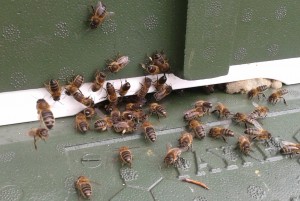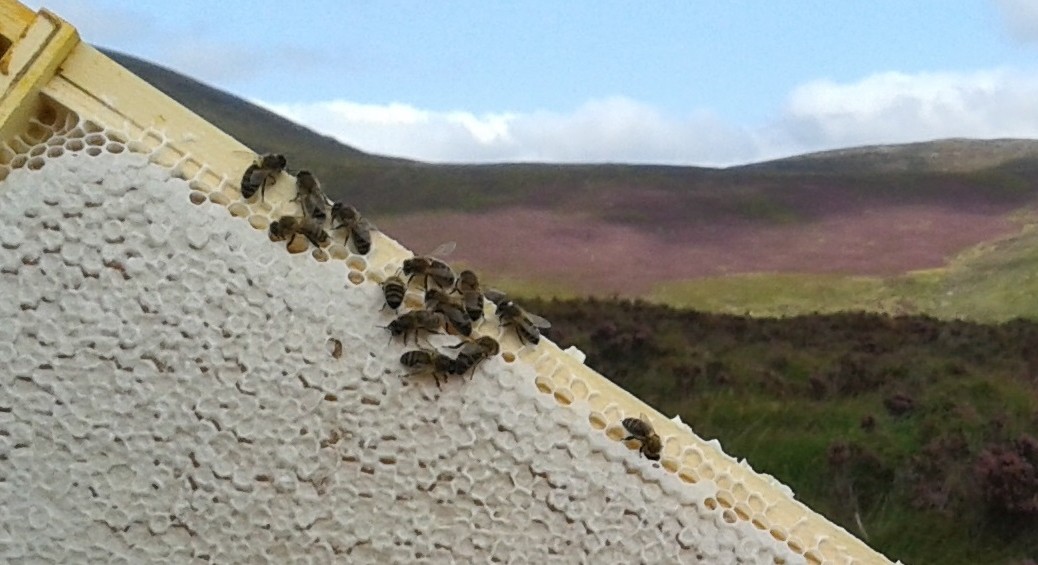In this part of the world – July is the time to get the bees to the heather – if the flow is early you’ll miss it. But before you do that – have you got a heather site?
Here are some notes on what makes a good one.
Finding a good heather site can be quite difficult bearing in mind the often difficult terrain, security and the needs of the bees. This one above has pluses and minuses but overall it is a good one.
Here’s a picture of the bees working yesterday (temperature only 12 degrees C) note the pale pinkish beige pollen loads. Bell heather is more white. Click photo for a close up.

The Plusses
- It is very high up the hill (440m or nearly 1500ft) and surrounded by stands of pure ling (Calluna vulgaris) with patches of bell (Erica spp) heather in amongst. The bees literally have their feet in the heather;
- Only upland heather sites will give you pure ling heather honey. The altitude here places any ivy (Hedera helix) out of range if the two flows do coincide which has been known in the past. Pure ling heather honey does not granulate unless it has something else in it – especially ivy. If you are producing sections or comb honey that’s the last thing you need!
- There are patches of rosebay willowherb (Chamerion or Epilobium angustifolium pollen loads are blue) up here where the ground has been disturbed for forestry or the like. In previous years the bees have brought this in along with the ling but it didn’t seem to make the heather granulate and the flavour and colour was only slightly paler than pure ling. Not a problem then.
- The site faces east so the sun gets them up early in the morning. Also it is in a little bowl in the hillside with rising ground behind which protects the bees from the prevailing westerly winds. West or north facing slopes can be very shady and cold;
- It is secure and well away from public roads and footpaths.
The Minuses
- The hawk-eyed amongst you will have noticed the heather beetle damage in for foreground but the heather is recovering well and there is plenty of forage despite that;
- It can be very windy up here and that is hard on the bees if they are trying to fly although any cyclists out there don’t need to be told about the pros and cons of a strong head wind – especially if you head out into one.
- There are other hazards though namely fellow residents and visiting bipeds;
- There are rather a lot of sheep on the hill but they have been recently shorn – at least one of these colonies is a bit on the assertive side and I trust them to look after themselves if anyone woolly comes rubbing.
- There are also deer and for the first time I saw wild goats here yesterday but they were at a respectful distance. Not sure how much of a threat they could be – they look rather hairy.
- Crocodiles (!) of hikers pass not far from here and the occasional lost one walks right by on the wrong track quite close to the bees. Fortunately the hives are not visible from the track. Even if they were – walkers aren’t usually the type to pitch stones or set fire to heather but you never know.
Click here for how to prepare bees for the heather
Click here for how to take a crop of heather honey
Click here for the Heather Ecosystem
Click here for how to get sections
Click here for Heather Honey recipe
Copyright © Beespoke.info, 2015. All Rights Reserved.
